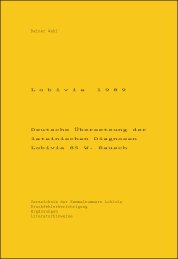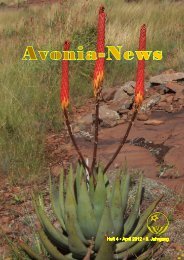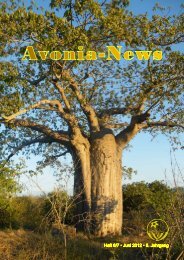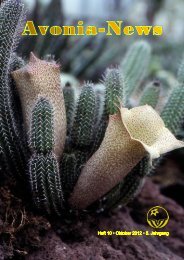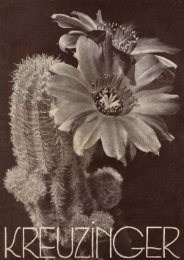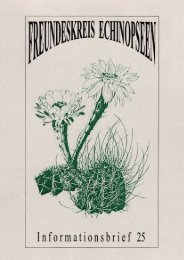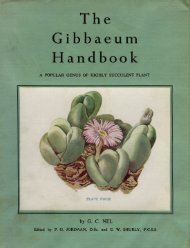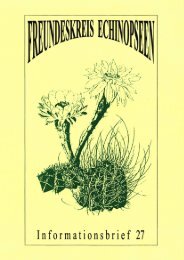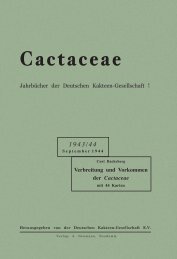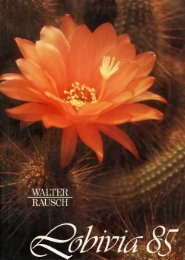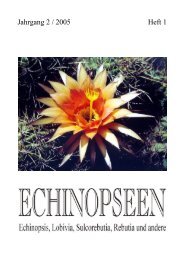Lithops - Au Cactus Francophone
Lithops - Au Cactus Francophone
Lithops - Au Cactus Francophone
You also want an ePaper? Increase the reach of your titles
YUMPU automatically turns print PDFs into web optimized ePapers that Google loves.
Koerpe chens > Koerper<br />
chens<br />
Kiesel mit starker Verwitterungsrinde an den Seiten mit roetlichem Anflug.<br />
Aeusserst bezeichnend und nie fehlend ist eine ockerbraune Linie oder eine<br />
Reihe ebensolche Punkte auf jeder Lippe des Spaltes, bisweilen auch am<br />
<strong>Au</strong>ssenrande d. Koerperchens. Die Bluete ist 3 cm. breit mit zahlreichen<br />
stumpflanzettlichen. 2 mm. breiten weissen Kronblaettern. Die Bluetenstiel<br />
ca. 15 mm. lang. fast zweischneidig, unter dein Fruchtknoten 93 mm. dick.<br />
Kelch 5 zipfelig, gruenlichhraun stark punktiert, alle Zipfel plus minus haeu<br />
tig umrandet, stumpf, gleich gross, an der Basis ca 5 mm. breit. Petalen<br />
ca 45–50, zweireihig, all der Basis frei, reinweiss, am oberen Teile 2 mm.<br />
breit, Stamina weiss, am Grunde kurz behaart 6–7 mm. lang. Staubbeutel<br />
gelblich weiss. Stigmata 5 bis zum Grunde frei, aufrecht mit rueckgekruemm<br />
ten Spitzen, hellgelb ca 10 mm. lang. Ovarium flach 5 faecherig mit etwas<br />
hochgerichtteten Faecherleisten. Durchm. 7–5 mm. Die Lippen d. Blaetter<br />
sind unterlagert von einem nicht scharf begrenzten Chlorophyllgewebe.<br />
S.W.A.: Haelfte des Weges zwischen Vahldorn nach Warmbad, spaeter<br />
auch der Naehe Warmbads.<br />
102<br />
okerbraune > ockerbraune<br />
24. LITHOPS KARASMONTANA<br />
<strong>Lithops</strong> karasmontana. (Plates 20, 20a. 20b.) Growths solitary or forming<br />
clumps of 2 or more. top more or less flat or convex; sides coloured mauve grey;<br />
rugu lose or slightly bullate at times, windows usually opaque; top uniform col<br />
our, light grey pale brown yellow, the depressions being of a darker tint or in<br />
the depressions brown ochre lines or at times only a brown ochre dot; here<br />
and there is a deeper depression; at times the depressions are of a dark green<br />
colouration forming a window and these depressions become confluent forming<br />
a fairly large semi transparent window. Flowers yellow.<br />
South West Africa: Karas Mts.: Kl. Karas Mts. among quartz pebbles;<br />
foot of Kl. Karas Mt. near Klein Karas. Fl. Oct. Nov.<br />
L. karasmontana is one of the most variable species of this genus. The varia<br />
tion is of a twofold nature: (1) The colour of the elevations or ridges varies<br />
front a light fawn grey, brown, dark brown, reddish brown to a distinct red<br />
dish tint. All these variations were observed in one of two clumps brought<br />
fresh from the field in South West Africa. An attempt has been made—by, I<br />
think, Schwantes—to nature a species L. Jocobseniana, mainly because of the<br />
reddish tint of the ripper surface. To tiny mind this is not a good species,<br />
and though it was not described it does appear in the literature. I reckon<br />
it should not be retained. (2) The colour of the depressions is also liable<br />
to vary. The variation from fawn, fawn grey, dark brown, ochre brown to a<br />
distinct brown with a tinge of red. In spite of these variations the species<br />
is easily recognised by (i) the peculiar rugose surface and (ii) the somewhat<br />
darker colour of the depressions. Fig. 58 shows clearly the range of the varia<br />
tion as all these plants conic front uric habitat. Fig. 59 shows quite distinctly<br />
the nature of the rugosity and the deeper colour of the depressions.<br />
met > mit



